History of corsets

The corset has been an important article of clothing for several centuries, evolving as fashion trends have changed. Women, as well as some men, have used it to change the appearance of their bodies.
The corset first became popular in sixteenth-century Europe, reaching the zenith of its popularity in the Victorian era. The earliest image of a possible corset was made ca. 2000 BC. The image is of a Cretan woman, and the article of clothing depicted might be perceived as a corset; however, it is worn as an outer-garment.[2] While the corset has typically been worn as an undergarment, it has occasionally been used as an outer-garment; corsets as outer-garments can be seen in the national dress of many European countries.[3]
The term "corset" is attested from 1300, coming from the French "corset" which meant "a kind of laced bodice." The term "stays" was frequently used in English from c. 1600 until the early twentieth century.[4][5]
16th and 17th centuries
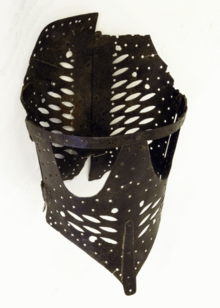
The corset as an undergarment had its origin in Italy, and was introduced by Catherine de Medici into France in the 1500s, where the women of the French court embraced it. This type of corset was a tight, elongated bodice that was worn underneath the clothing.[3] The women of the French court saw this corset as "indispensable to the beauty of the female figure."[6] Corsets of this time were often worn with a farthingale that held out the skirts in a stiff cone. The corsets turned the upper torso into a matching but inverted cone shape. These corsets had shoulder straps and ended in flaps at the waist. They flattened the bust, and in so doing, pushed the breasts up. The emphasis of the stays was less on the smallness of the waist than on the contrast between the rigid flatness of the bodice front and the curving tops of the breasts peeking over the top of the corset. These corsets were typically made out of layered fabric, stiffened with glue, and were tightly laced. While a few surviving corsets exist that are structured with steel or iron, these are generally considered to have been either orthopedic or novelty constructions and were not worn as part of mainstream fashion.[7]
By the middle of the sixteenth century, corsets were a commonly worn garment among European and British women. The garments gradually began to incorporate the use of a "busk," a long, flat piece of whalebone or wood sewn into a casing on the corset in order to maintain its stiff shape. The front of the corset was typically covered by a "stomacher," a stiff, V-shaped structure that was worn on the abdomen for decorative purposes.[7]
In the Elizabethan era, whalebone (baleen) was frequently used in corsets so bodices could maintain their stiff appearance. A busk, typically made of wood, horn, ivory, metal, or whalebone, was added to stiffen the front of the bodice. It was then carved and shaped into a thin knife shape and inserted into the Elizabethan bodice, then fastened and held into place by laces, so that the busk could be easily removed and replaced.[8] The busk was often used for special occasions and events, and was sometimes presented to a suitor as a prize when he was interested in a female (Ewing, 1978, 29). Since the mid-Victorian period, the busk has been made of steel and consists of two parts, one for each side. One side has studs and the other eyes so that the corset can be easily fastened and unfastened from the front.[9] During the late 1500s, when whalebone was used at the sides and back of the corset, the corset was laced up at the front. Eventually, the lacing came to be done at the back of the corset.[8]
Even as it gained popularity, the corset was not worn by everyone. Mary, Queen of Scots, for example, did not wear a corset.[10] During the reign of Louis XV of France and again during the French Revolution, the corset went out of style, as the fashions were simpler.[10]
18th and early 19th centuries
The most common type of corset in the 1700s was an inverted conical shape, often worn to create a contrast between a rigid quasi-cylindrical torso above the waist and heavy full skirts below. The primary purpose of 18th-century stays was to raise and shape the breasts, tighten the midriff, support the back, improve posture to help a woman stand straight, with the shoulders down and back, and only slightly narrow the waist, creating a 'V' shaped upper torso over which the outer garment would be worn; however, 'jumps' of quilted linen were also worn instead of stays for informal situations. Jumps were only partially boned, did little for one's posture, but did add some support. Both garments were considered undergarments, and would be seen only under very limited circumstances. Well-fitting eighteenth-century corsets were quite comfortable, did not restrict breathing, and allowed women to work, although they did restrict bending at the waist, forcing one to protect one's back by lifting with the legs.
By 1800, the corset had become primarily a method of supporting the breasts, as the waist was raised to just under the bust line. Corsets still slimmed the torso but this was not their primary purpose.
 Regency short stays circa 1810
Regency short stays circa 1810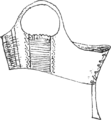 Short stays circa 1803
Short stays circa 1803 Nursing Corset
Nursing Corset
US-Patent 169,159 (1875)
The corset became less constricting with the advent of the high-waisted empire style (around 1796) which de-emphasized the natural waist. Some form of corset was still worn by most women of the time but these were often "short stays" (i.e. they did not extend very far below the breasts). By contrast, corsets intended to exert serious body-shaping force (as in the Victorian era) were "long" (extending down to and beyond the natural waist), laced in back, and stiffened with boning.
Transition to the Victorian
When the waistline returned to its natural position during the 1830s, the corset reappeared and served the dual purpose of supporting the breasts and narrowing the waist. However, it had changed its shape to the hourglass silhouette that is even now considered typical both for corsets and for Victorian fashion. At the same time, the term corset was first used for this garment in English. In the 1830s, the artificially inflated shoulders and skirts made the intervening waist look narrow, even with the corset laced only moderately.
In 1839, a Frenchman by the name of Jean Werly made a patent for women's corsets made on the loom. This type of corset was popular until 1890 when machine-made corsets gained popularity. Before this, all corsets were handmade - and, typically, home-made.[11]
The Victorian corset
When the exaggerated shoulders disappeared, the waist itself had to be cinched tighter in order to achieve the same effect. The focus of the fashionable silhouette of the mid- and late 19th century was an hourglass figure with a tiny waist. It is in the 1840s and 1850s that tightlacing first became popular. The corset differed from the earlier stays in numerous ways. The corset no longer ended at the hips, but flared out and ended several inches below the waist. The corset was exaggeratedly curvaceous rather than funnel-shaped. Spiral steel stays curved with the figure. While many corsets were still sewn by hand to the wearer's measurements, there was also a thriving market in cheaper mass-produced corsets.
 1859 corset with built-in partial crinoline
1859 corset with built-in partial crinoline 1869 corset
1869 corset 1878 corset
1878 corset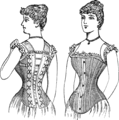 1890 corset
1890 corset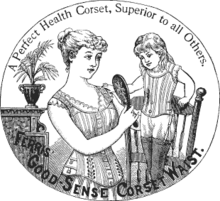 "Perfect Health" Corset
"Perfect Health" Corset
c 1890.
Late 19th century
In the late 19th century concern about reports of tight-lacing caused a movement for rational dress. Some doctors were found to support the theory that corsetry was injurious to health (particularly during pregnancy) and women who did tight lacing were condemned for vanity and excoriated from the pulpit as slaves to fashion. In reality, tight corseting was most likely the cause of indigestion and constipation but rarely the cause for a plethora of ailments associated with tight corseting at the time ranging from hysteria to liver failure.[12]
In part as a response to the perceived dangers of tight-lacing, but also due to women's increasing interest in outdoor activities, "health corsets" became popular during the late 19th century. In 1884, A German physician, Dr. Gustav Jaeger (1832-1917) came up with wool sanitary corsets, described as flexible and elastic.[13] They were also durable and respondent to movements. Dr. Jaeger claimed that the wool had curing capabilities and that it had cured him of his chronic health problems: excess of weight and indigestion[14] Another was created in 1887, a dermathistic corset with leather facing. It was marketed towards women who wanted better health and enjoyed a vigorous lifestyle.[15]
The Edwardian corset

The straight-front corset, also known as the swan-bill corset, the S-bend corset or the health corset, was worn from circa 1900 to the early 1910s. Its name is derived from the very rigid, straight busk inserted in the center front of the corset. This corset forced the torso forward and made the hips jut out in back.
The straight-front corset was popularized by Inez Gaches-Sarraute, a corsetiere with a degree in medicine. It was intended to be less injurious to wearers' health than other corsets in that it exerted less pressure on the stomach area. However, any benefits to the stomach were more than counterbalanced by injury caused to the back due to the unnatural posture that it forced upon its wearer. At this time, the bust lowered and corsets provided much less support for the breasts.
By ca. 1908 corsets began to fall from favor as the silhouette changed to a higher waistline and more naturalistic form. Early forms of brassieres were introduced and the girdle soon took the place of the corset which was more concerned with reducing the hips rather than the waist.
 A photo from Robert Wilson Shufeldt's 1908 book Studies of the human form for artists, sculptors, and scientists illustrates the narrowing of the waist achieved with a corset.
A photo from Robert Wilson Shufeldt's 1908 book Studies of the human form for artists, sculptors, and scientists illustrates the narrowing of the waist achieved with a corset.
Post-Edwardian long line corset
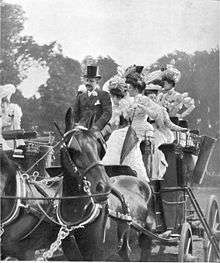
From 1908 to 1914, the fashionable narrow-hipped and narrow-skirted silhouette necessitated the lengthening of the corset at its lower edge. A new type of corset covered the thighs and changed the position of the hip, making the waist appear higher and wider. The new fashion was considered uncomfortable, cumbersome, and furthermore required the use of strips of elastic fabric. The development of rubberized elastic materials in 1911 helped the girdle replace the corset.[16]
After World War I
Shortly after the United States' entry into World War I in 1917, the U.S. War Industries Board asked women to stop buying corsets to free up metal for war production. This step liberated some 28,000 tons of metal, enough to build two battleships.[17] The corset, which had been made using steel stays since the 1860s, further declined in popularity as women took to brassieres and girdles which also used less steel in their construction. However, body shaping undergarments were often called corsets and continued to be worn well into the 1920s.
Changes in the economy after World War I also changed women's roles in society. In the early 20th century, a young woman would typically have started wearing a corset at about 15 years old, and live at home until she married around age 18. After the war, more young women sought an education, and in the Western world, marriage was delayed until they reached their middle to late 20s. Only overweight or pregnant women might choose to wear a corset, typically an under-bust corset.
However, these garments were better known as girdles with the express purpose of reducing the hips in size. A return to waist nipping corsets in 1939 caused a stir in fashion circles but World War II ended their return. In 1952,[18] a corset known as 'The Merry Widow' was released by Warner's. Initially, the merry widow was a trademark of the famous Maidenform company, which designed it for Lana Turner's role in a 1952 movie of the same name.[19] The Merry Widow differed from earlier corsets in that it separated the breasts, whereas corsets had held them together. Both the Merry Widow and girdles remained popular through the 1950s and 1960s. In the 1990s, fetish fashion became popular and corsets made something of a recovery, often worn as outer- rather than undergarments. By 2010, the corset had recovered a new popularity in fashion. By October 2016, corsets were receiving large numbers of reviews on Amazon, one UK garment attracting 858 reviews. A similar garment in the USA received over two thousand reviews
Ecological ortopedic elastic corset (unisex)
The useful model belongs to medical equipment, namely to bandages,[20] belts and corsets of the lower department of a backbone and can be used in the course of medical, preventive, rehabilitation and esthetic impact to soft tissues in a backbone at osteochondrosis, at injuries after operations, at treatment of the available frustration and for restoration of the lost functions.[21]
See also
- Brassiere
- Corsages
- Corselettes
- Corset
- Corset controversy
- Corsetmaker
- Girdles
- Rib removal
- Tightlacing
References
- ↑ Takeda, Sharon Sadako; Spilker, Kaye Durland (2010). Fashioning Fashion: European Dress in Detail, 1700–1915. Prestel USA. p. 76. ISBN 978-3-7913-5062-2.
- ↑ Elizabeth Ewings, Dress and Undress: A history of Women's Underwear (New York: Drama Book Specialists, 1978), 19.
- 1 2 Ewings, Dress, 22
- ↑ "Online Etymology Dictionary". Etymonline.com. Retrieved 2013-08-18.
- ↑ "Online Etymology Dictionary". Etymonline.com. Retrieved 2013-08-18.
- ↑ Gleason's Pictorial Drawing Room Companion (1851-1854), 12/1854, Volume 7, Issue 26, p. 412
- 1 2 Tortora, Phyllis G., and Keith Eubank. A Survey of Historic Costume. 5th ed. New York: Fairchild Publications, 1989. Print. p. 215
- 1 2 Ewings, Dress, 29
- ↑ Ewings, Fashion , 27
- 1 2 Gleason's Pictorial Drawing - Room Companion (1851-1854), 12/1854, Volume 7, Issue 26, p. 412
- ↑ Ewings, Fashion , 41
- ↑ Mel Davies, 'Corsets and Conception: Fashion and Demographic Trends in the Nineteenth Century' in Comparative Studies in Society and History, Vol. 24, No. 4 (Oct., 1982), pp. 611-64}
- ↑ "FIDM Museum Blog: Jaeger wool corset, 1890s". blog.fidmmuseum.org. Retrieved 2016-01-30.
- ↑ Ewings, Fashion , 68
- ↑ Cunnington, C. Willett, Phillis Cunnington, A. D Mansfield, and Valerie Mansfield. The History of Underclothes. (London: Faber and Faber, 1981) 125
- ↑ Carlisle, Rodney (2004). Scientific American Inventions and Discoveries, p.102. John Wiley & Songs, Inc., New Jersey. ISBN 0-471-24410-4.
- ↑ Phelps, Brian. "May Phelps Jacob". Retrieved 2-11-2010. Check date values in:
|access-date=(help) - ↑ Store Operations: Cinch Bra Gets Glamour Treatment. (1952, March 18). Women’s Wear Daily, 84(54), 67.
- ↑ "What is a Merry Widow? (with picture)". wiseGEEK. Retrieved 2016-01-27.
- ↑ Bandage definition
- ↑ elastic corset (ru)
External links
| Wikimedia Commons has media related to History of corsets. |
| Wikisource has original text related to this article: |
| Wikisource has original text related to this article: |
| Wikisource has original text related to this article: |



